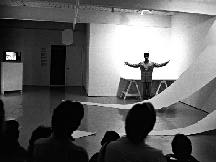- MAIN INDEX | ARTIST INDEX
| August 30 - September 17, 1983 Richard Layzell
| |
 Richard Layzell, installation view of "Who's Cool? (Trying to Reach You) an exhibition on the move", 1983. Photo Peter MacCallum. 18K |  Richard Layzell, view of performance "Who's Cool? (Trying to Reach You) an exhibition on the move", 1983. Photo Peter MacCallum. 18K |
| PRESS RELEASE Richard Layzell was invited to Canada for an exhibition and a series of performances (August 30 September 17) by Mercer Union. This trip was made possible through the support of the Canada Council's Visiting Foreign Artists Programme and the British Council. Mercer Union organised a cross-country tour for Richard Layzell so that other Canadians would be able to learn and share through the visit of this outstanding British artist. His performances, lectures and installation drew large and enthusiastic crowds across Canada. The many artists and students who were in contact with Layzell appreciated his professionalism and integrity as both an artist and a humanitarian. During, Richard Layzell's two month visit he travelled throughout Ontario, Alberta, British Columbia and Quebec giving workshops, lectures and performances. As well as completing new work for the installation at Mercer Union, Layzell completed the production of a new video at the Western Front in Vancouver. The new video had its premiere at S.A.W. Gallery in Ottawa and was received with a standing ovation. Layzell's visit has aided Mercer Union in maintaining its international mandate and extending this opportunity to others across Canada. The Visiting Foreign Artists Programme promotes the opportunity for artistic and cultural exchange which is vital to Canada's own artistic growth. PRESS RELEASE Richard Layzell is a British artist who works in mixed media - from installation to video to performance. He is currently concerned with the gap between fine art and popular culture. To this end, his most recent performance, "Zangst", was shown in a bar, a night club and a discotheque. "Who's Cool" will be an improvised installation, using assemblage video and sound in an attempt to engage the viewer in a direct dialogue. During the three week show, Layzell will be present in the gallery as part of the exhibition, playing different roles: sometimes as performer, sometimes as artist, sometimes as object, sometimes as friend, sometimes as an embarrassment. Two different performances on August 30th and September 17th will involve sound, gesture, dialogue and audience interaction, giving an added dimension to the exhibition. During his stay in Canada, Layzell will be travelling across the country giving performances and workshops as well as producing a video. "Richard Layzell's performances are reenactments of the post-trial ego and id. He disconverts timespace by subverting relationships of mind and body, of personal and public presence....Richard worked that night at CLUB FOOT on a stage emptied of symbolic or literary reference....He spoke to us in a personable way, including us in a gestalt situation wherein "stage", "actor" and "audience" worked together to create the whole....The post-historic meets the prehistoric." 1982, ART COM, San Francisco Pierre Savatier and Richard Larzell, at Mercer Union
John Bentley Mays Two separately conceived installations which surprisingly come together as a single tale of two countries (Savatier is French; Layzell is English) and two contemporary artistic attitudes. The more severe and elegant of the two is Savatier's array of photographs, distributed far apart on walls painted flat white and flat black, and at odd heights and angles. One melancholy sequence of images seems to describe an apprehensive woman walking down a boardwalk - but whether it does or not doesn't matter. Savatier's main concern seems to be philosophy, not narrative. And, if you had to name the philosophers Savatier seems most interested in, Heidegger would be at least one choice - simply because this artist, like Heidegger (and like many interesting European performance artists active before the recent painting avalanche), is principally engaged with the large conceptual issues of time, space, perception and situation. You can appreciate Savatier's piece. You can actually like Layzell's, which is a personal, humane piece about birds, the reality and symbolism thereof, especially their usefulness as symbols of peace. To remind us to think about peace - the show's explicit aim - Layzell has provided a videotaped bird's-eye view of Toronto, a big wall piece built up from large, scrappy drawings of hands and wings, lightly, stapled down, large scarf-like scraps of paper, suggesting wings, and other elements. The piece could be destroyed in 10 seconds with a cigarette lighter, or ripped down in not much more time, it is that vulnerable. And that vulnerability to damage (and, by implication, to the contempt of cynics, high-art prejudice against such flimsy stuff, etc.) is one component of the piece - a reminder of how fragile a thing peace is. If this all sounds precious, it isn't. It is, however, out of sync with most artistic discourse in Toronto, which is a good reason to see the show.
| |